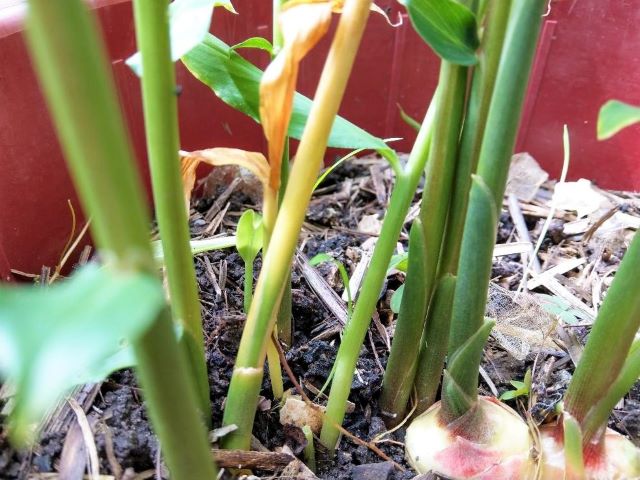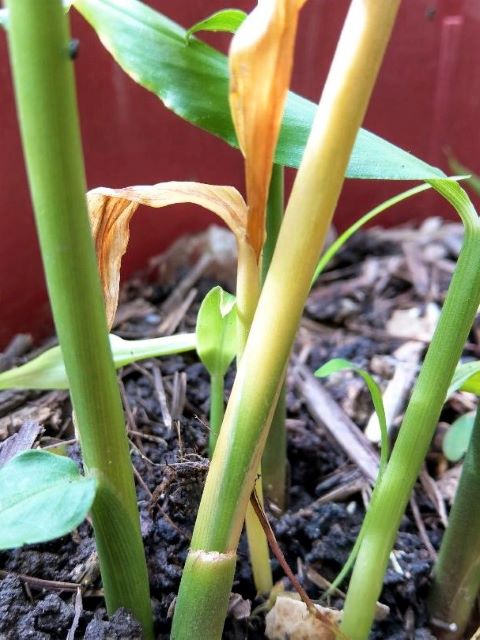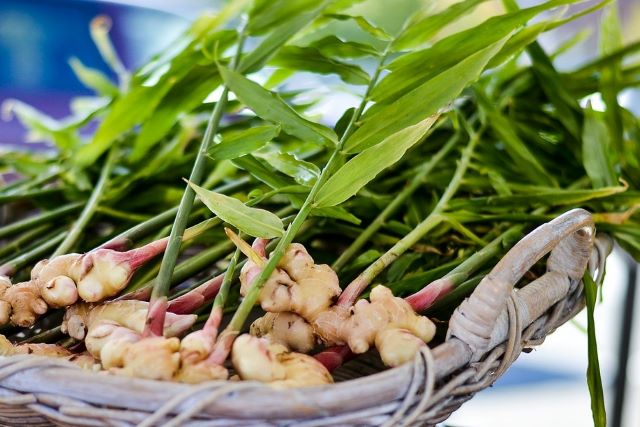Ginger is a very hardy plant, which makes it a great choice for gardeners. Plus, it’s delicious, and is great for indoor gardening. But sometimes, ginger can run into growing problems.

If your ginger plant is dying, you probably want to know why so you can fix the issue. In this article, I’ll talk about the common reasons why ginger plants die, and how each one of them can be treated, prevented, or fixed.
The most common reasons for ginger plants dying are incorrect watering, too much light, the wrong temperature, not enough humidity, not enough fertilizer, or ginger plant diseases.
So what can you do about each of these? Let’s take a look.
Table of Contents
Watering Problems Can Cause Ginger Plants to Die
If your ginger plant’s leaves are starting to turn brown, and perhaps even looking a little dry, it’s usually a sign that the plant isn’t getting enough water.
Ginger is fairly hardy when it comes to watering issues, but it doesn’t like to dry out completely. Once this happens, it will start to struggle. So to prevent your ginger from dying, wait until the top bit of soil dries out, and then soak the soil. Typically, it needs to be watered about once or twice a week.
If the plant is in a pot, make sure it has good drainage holes. While ginger likes water, it doesn’t like to sit in waterlogged soil. Additionally, don’t water a lot before the plant has taken root, as this can actually make it more difficult for roots to spread and lead to growing problems.
If your ginger leaves are turning brown and the soil is dry, give it a healthy watering, and watch as the plant bounces back in no time.

Too Much Light Cause Ginger Plants to Die
Ginger plants like heat (more on that soon). However, that doesn’t mean they like too much light. Ginger needs bright, indirect light to grow.
If it gets too much direct light, the leaves will brown. This can also cause the soil to dry out faster, making it more difficult to water properly.
If you have your ginger in a bright windowsill, or outside in the sun, move it somewhere where it will have full or partial shade. It should still get sunlight, just not a lot of it directly on the leaves.
For outside plants, you can place your ginger plant in a place shaded by a tree, deck, or corner of the house. Having taller plants nearby can also help give the ginger plant shade, as long as they have enough space that the roots won’t compete.
This being said, ginger isn’t a low-light plant. It still needs a lot of light, just not too much direct light, as that will damage the leaves. So make sure you’re giving it a lot of light, but shading it from the sun’s direct rays.
Incorrect Growing Temperature Can Cause Ginger Plant to Die
Ginger is a tropical plant, which means it prefers heat. That being said, it is more moderate, and too much heat (or direct light) can be bad.
The ideal temperature range for growing ginger is 75-85 °F (24-30 °C). This is when the plant will thrive the most. It can also tolerate heat that’s a bit higher than this range.
Many varieties of ginger are hardy as low as 20 °F (-6 °C). However, don’t let that fool you into thinking ginger likes cold. Generally, anything below 60 °F (15 °C) is to cold for ginger, at least if you want to keep harvesting it.
That’s because while it may survive down to 20 °F (-6 °C), it will likely go dormant in cold temperatures. This means the leaves will die off, but the rhizomes beneath the soil will stay alive until the temperature gets high enough for it to grow again.
Since ginger is a perennial, and one that grows vigorously, you can keep it growing all year if you want. To do this, don’t let the temperature drop below 60 °F (15 °C), so the plant doesn’t go dormant. If you’re growing inside, that shouldn’t be a problem. Outside, you may not be able to prevent dormancy, unless you live in a very warm climate. However, you could always bring your ginger inside during the colder months so it can keep growing.
Lack of Humidity Can Cause Ginger Plant to Die
Because ginger is a tropical plant, it likes to have a lot of humidity. If the air is too dry, ginger plants may not grow very well, and can even start to die.
When growing ginger outside, this isn’t as much of a problem, unless you live in an area where the air is often dry. Inside, this can often be an issue, because the air in homes is usually dry and stagnant.
Luckily, there are a lot of ways to give your ginger plants a boost in humidity.
Whether outdoors or indoors, misting ginger plants every day will give them the humidity they need. All you need for this is water and a misting bottle, which you can get cheaply at most gardening stores.
For indoor ginger plants, you could also add a humidifier to the room the ginger is in. If you have other indoor plants that need humidity, why not put them all in one room and add a humidifier?
Lastly, you can use pebble trays. This is my favorite way to add humidity to my plants’ environments because it doesn’t require daily work on my end.
Simply add a tray of pebbles somewhere near the base of your plant. You could even fill the drainage tray with pebbles. Then, add water. The water will evaporate over time, adding more humidity to the air. When there’s no more water in the tray, simply add more.
Whatever method you choose, just be sure to give your ginger the humidity it craves to replicate its natural tropical environment.
Lack of Fertilizer Can Cause Ginger Plant to Die
Ginger needs a lot of soil nutrients to grow successfully. Giving it fertilizer or compost a few times a year will help boost your ginger crop and keep the plant happier.
When ginger isn’t getting enough nutrients, the edges of the leaves will brown, while the centers turn yellow. This is a sign that your ginger plant is malnourished, and you need to do something about that. Luckily, it’s not hard to fix.
All you need to do is give your ginger some nutrients. This can be done through a well-balanced fertilizer, such as this organic edible garden fertilizer. Alternatively, you can use compost, or compost tea, which is a great option.
While ginger needs nutrients, it won’t need them to be applied all the time. Giving ginger fertilizer two to three times a year should be enough. And if your ginger goes dormant in the winter, it won’t need more fertilizer until the spring.
Ginger Plant Diseases That Cause Plants to Die
Ginger plants can get diseases that will slow growth and possibly leave you with a dying ginger plant. Many of these diseases are preventable, although they are hard to treat.
One of the most common ginger plant diseases is bacterial wilt. As the name suggests, this is a bacterial disease. It causes gray discoloration on the rhizomes and stems, and eventually will cause the plant to die.
Bacterial wilt thrives on moisture, so prevent overwatering your ginger plants. Additionally, try to avoid leaving open wounds on the plant. If there are any, make sure dirt doesn’t get into them. If bacterial wilt does take hold and treatment isn’t helping, remove infected plants immediately to prevent it from spreading. Rotating your planting location also helps, or, if indoors, not using the same soil for a new batch of ginger.
Rhizome rot is similar to root rot, but it affects ginger very badly, since most of ginger is the rhizome beneath the soil. It’s very difficult to treat, so prevention is the key. Rhizome rot thrives in wet, warm soil. Overwatering ginger is a sure way to end up with rhizome rot.
This disease will cause the roots and rhizome of your ginger to turn soft and mushy. The roots may go from white to black, and be soft to the touch. If you notice this occurring, get rid of the infected plant immediately. Rhizome rot can stay in the soil for a long time, so it’s good to replace the soil before planting more ginger.
Lastly, leaf spot causes white spots on the leaves of your ginger. Over time, these spots will spread, and eventually, the plant will wilt and die. You can remove infected leaves as soon as you notice them to try and prevent it from spreading.
Again, try to prevent overwatering. Also, leaf spot spreads very easily through rain and wind. So if you’re not able to treat it, you should remove the infected ginger plants so it doesn’t spread to others.
Here is an organic biofungicide that you can try to use if you notice disease affecting your ginger. It can potentially kill and treat multiple different diseases. However, there’s no guarantee it will work. When it comes to ginger plant diseases, the best option is prevention.
Some gardeners say that neem oil helps them treat diseases like bacterial wilt and leaf spot. This is certainly worth a shot, but you can’t be sure it will work. When it comes to ginger diseases, the only surefire options are to prevent them when possible and remove when necessary.
So there you have the most common reasons why your ginger plant is dying and how to fix them. And when you achieve the right growing conditions, nothing beats harvesting your own bumper crop of ginger from your garden. If you would like to learn more about growing ginger, you might like to check out our article: How To Grow Ginger: Guide To Growing Ginger At Home.

Further reading:
- Are Ginger Leaves Edible? (And how to eat them!)
- How to Grow Turmeric and Make Your Own Turmeric Powder
- Curry Leaf Plant: Growing, Caring and Eating Curry Leaves
- How To Grow Garlic: Growing And Harvesting The Best Garlic
- How to Grow Lemongrass: Planting and Growing Guide
- Why Is My Lemongrass Plant Dying? Causes and Solutions
